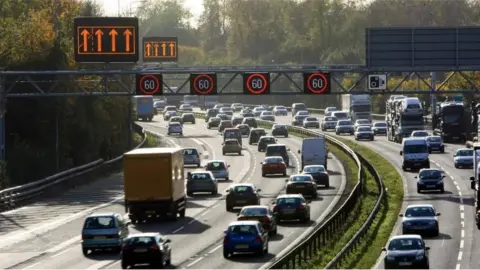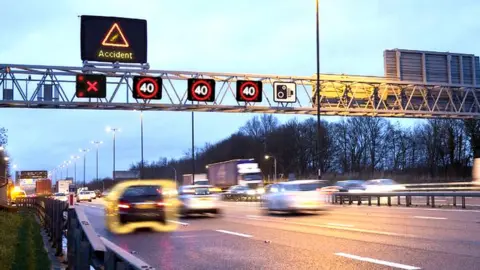What are smart motorways and are they dangerous?
 PA
PAThe technology used to manage England's smart motorways has stopped working hundreds of times, the BBC's Panorama has found.
The government announced last year that it will stop building new stretches of these roads, following concerns about cost and safety.
What is a smart motorway?
Smart motorways were designed to ease traffic flow, with some using the hard shoulder as an extra lane.
Technology is used to regulate traffic flow and ease congestion.
As of April 2024 there were 396 miles of smart motorways in England:
- All-lane running motorway - hard shoulder permanently removed - 193 miles
- Controlled - hard shoulder retained and variable speed limits - 140 miles
- Dynamic - hard shoulder sometimes open to traffic - 63 miles

All three types of smart motorway use overhead gantries to direct drivers.
Variable speed limits, controlled by speed cameras, manage traffic flow when there is congestion, or if there is a hazard ahead.
On dynamic motorways, the overhead gantries also tell drivers whether or not they can drive on the hard shoulder.
A red X is displayed if a lane is closed, for example, because of an accident or breakdown. Traffic is monitored using CCTV.
All-lane-running schemes operate in the same way, except there is no hard shoulder at all.
If drivers get into trouble, they are meant to aim for emergency refuge areas (essentially lay-bys) at intervals along the road.
Are smart motorways dangerous?
Motorways in general account for far fewer casualties than rural or urban roads.
And National Highways, which manages England's motorways, says the latest data shows that "smart motorways are our safest roads".
However, the removal of the hard shoulder on some smart motorways has concerned critics.
If a vehicle breaks down, or if there is an accident, vehicles can be left stranded and emergency services may struggle to get through.
National Highways' latest figures suggest that if you break down on a smart motorway without a hard shoulder you are three times more likely to be killed or seriously injured than on one with a hard shoulder.
 Gov.uk
Gov.ukAcross all smart motorways, radar and cameras are supposed to spot broken-down vehicles, and warning signs are then supposed to close affected lanes.
However, in April, figures obtained by Panorama revealed hundreds of incidents when crucial safety equipment was out of action.
National Highways says radar detects 89% of stopped vehicles - but that means one in 10 is not spotted.
At least 79 people have been killed on smart motorways since they were introduced in 2010. In the past five years, seven coroners have called for them to be made safer.
What are government plans for smart motorways?
In 2021, MPs on the Transport Committee said they were "not convinced" that the benefits of all-lane-running motorways were enough to justify the safety risks of permanently removing the hard shoulder.
Then, in January 2022, the rollout of new stretches of all-lane-running was paused for five years, in order to collect more information and make existing schemes safer.
Ministers have since gone further, and in 2023 cancelled the building of new smart motorways - this included 11 schemes that were already on pause and three earmarked for construction.
However, work on some stretches of smart motorway that were near completion were allowed to continue.
In 2020, the government promised to build more emergency refuges - safety lay-bys that motorists can use if they are in trouble. Although 150 are supposed to be built by next year, only 13 have been completed so far.
National Highways says a further 34 refuges are under construction.
The government says it is also spending £900m on technology to make the existing network safer, but there are no plans to put back the hard shoulder.
